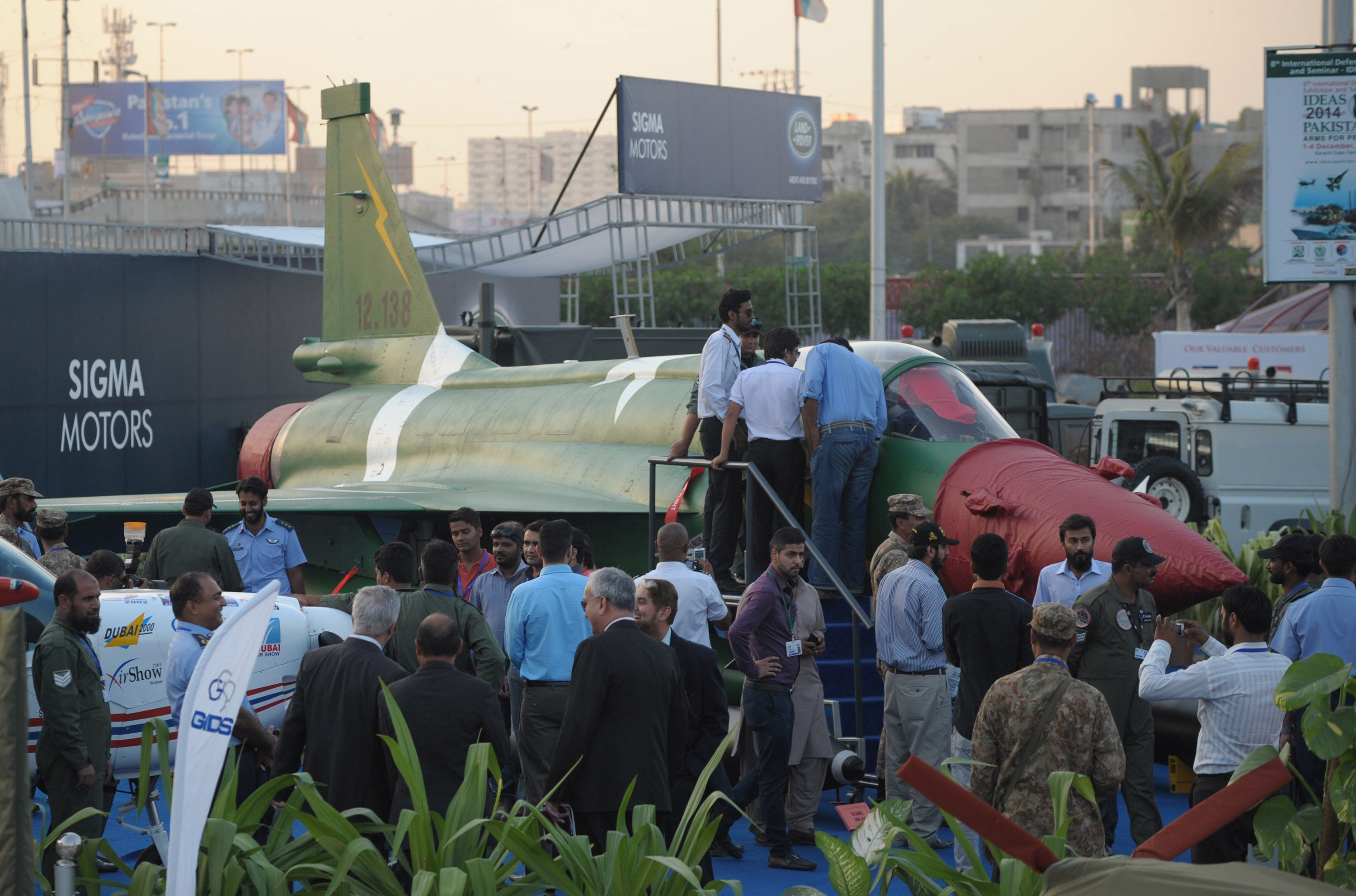
KARACHI: A revamped version of JF-17 jet fighter took centre stage at 8th International Defence Exhibition and Seminar (IDEAS) in Karachi this week as the country looks to boost its role as a military exporter on the world stage.
Pakistan's military has long been a major importer of defence equipment, particularly from key ally China.
But the country is hoping the updated JF-17, conceived and initially developed with the help of China, along with Pakistani-made tanks and surveillance drones, will help grow military exports and bring in much-needed foreign exchange revenue.
The country's forex reserves are slowly recovering after falling to just $3 billion in November 2013, from nearly $15 billion in 2011.
But the economy is still shackled by a long-running energy crisis and growth remains sluggish, predicted at 4.3 percent this financial year.
The new JF-17, which is manufactured at the Pakistan Aeronautical Complex (PAC) just west of Islamabad, was among the key exhibits at the four-day event.
The plane will initially be handed over to the Pakistan Air Force (PAF), which is currently carrying out air strikes against militants in North Waziristan.
"We will hand over 16 Block-II JF-17s to the PAF every year," said Air Marshal Javaid Ahmad.
He said the first five would be delivered this month and the plant has the capacity to produce 25 aircraft per year.
The air force started using the first edition of the JF-17 in 2010, having historically relied on US imports during wars.
It has deployed F-16s in recent attacks on insurgents in the tribal regions that border Afghanistan, but not its own home-made fighters.
After the Cold War ended Pakistan began to deepen defence and economic ties with ally China, culminating in the test flight of the jet's prototype in Chengdu in 2003.
China earlier this month promised investment worth $42 billion in Pakistan mainly centred on the energy sector.
Ahmad did not disclose the jet's sale price, but added: "Several developing countries have shown keen interest in buying JF-17s from Pakistan."
Sources close to the issue said countries in Central Asia, South America and Africa have expressed interest.
The Block-II JF-17 has improved avionic systems, air-to-air refuelling capability, additional weapons carriage capability and some extra operational capabilities, according to the air force.
It is designed as a lightweight multi-role aircraft, with a claimed top speed of Mach 2.0 and operational ceiling of 55,000 feet.
Analyst Hassan Askari said Pakistan would likely be hoping to market the jet on its competitive price, particularly to Gulf states where it already sends military training missions.
While officials are staying tight-lipped about the sale price, it is likely to be substantially less than the $16-18 million cost of an F-16.
"It will be a new kind of role for Pakistan after it markets the new plane for sale," he said.
"Pakistan will have economic dividends and you come in the category of the countries which have advanced technology."
The biennial IDEAS arms fair has expanded to its largest ever size for its eighth edition this year, with 209 companies from 23 countries attending.
According to the government's Defence Export Promotion Organisation, Pakistan has sold arms, aircraft and ammunition to more than 35 countries around the world over the past two years.
The state-owned Heavy Industries Taxila (HIT), which makes armoured vehicles and body armour, exports its al Zarrar tanks to developing countries including Bangladesh, Sri Lanka, Myanmar and Nigeria.
Lt Colonel Amir Ahmed Khan, HIT's deputy director, marketing and procurement, told AFP the company was now working on a deal to sell its al Khalid tanks to Saudi Arabia.
"We are in a very advanced stage of striking the deal with Saudi Arabia and already they have used the tanks on a trial basis," Khan said.
Leading analyst retired Lieutenant General Talat Masood cautioned that potential buyers would need to consider long-term maintenance, and whether parts would continue to be produced for the plane's expected 25-year lifespan.
"The main advantage for Pakistan will be the production line will keep going, industrial and technological base will expand and we will be able to earn foreign exchange," he said.
And Pakistan-produced aircraft have not been without their problems.
Two Mushshak trainer planes, which Pakistan manufactures and exports, mainly to the Gulf, have crashed this year in routine missions.
Two pilots were killed in the first incident in April while two were injured in the second in September.
COMMENTS (1)
Comments are moderated and generally will be posted if they are on-topic and not abusive.
For more information, please see our Comments FAQ

































































At present JF-17 is making use of Russian RD93 Jet engine and avionics of Europe. I hope in the future Pakistan will be able to develop all the parts locally as indigenous development is important for sustainable growth. I hope PAC will start local research and development project of Engine Development along with Radar development. There must be a difference in local assembly and local manufacturing. With local state of the art research we can generate thousands of highly skilled workforce.